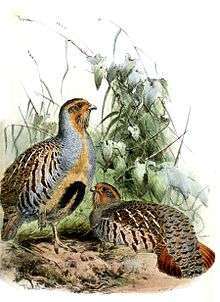Daurian partridge
The Daurian partridge (Perdix dauurica) is a gamebird in the pheasant family Phasianidae of the order Galliformes, gallinaceous birds. The name derives from the Dauria region of Russia.
| Daurian partridge | |
|---|---|
 | |
| Scientific classification | |
| Kingdom: | Animalia |
| Phylum: | Chordata |
| Class: | Aves |
| Order: | Galliformes |
| Family: | Phasianidae |
| Genus: | Perdix |
| Species: | P. dauurica |
| Binomial name | |
| Perdix dauurica (Pallas, 1811) | |
This partridge breeds on farmland across much of temperate eastern Asia from Kyrgyzstan east to China and Mongolia. It is a non-migratory terrestrial species, which forms flocks outside the breeding season. In parts of its range, it overlaps with the very similar and closely related grey partridge, with which it forms a superspecies.
Daurian partridge is a bird of open country, ideally with some adjacent bushes or light woodland. The nest is a lined depression in or near cover, and the typical clutch is 18–20 eggs.
It is a rotund bird, 28–30 cm (11–12 in) long, brown-backed, with an orange face and an orange bristly "beard" in the breeding season. The rest of the head and the underparts are grey with a buff central chest and a black belly patch. The female has a smaller belly patch and is duller than the male. Young Daurian partridges are essentially grey-brown, and lack the distinctive face and underpart markings. The song is a hoarse kieerr-ik.
There are three subspecies differing mainly in the plumage becoming darker and more rufous further east.
This is a seed-eating species, but the young in particular take insects as an essential protein supply. When disturbed, like most of the gamebirds, it flies a short distance on rounded wings, often calling rick rick rick as it rises.
Daurian partridge is not globally threatened, but may be over-hunted in parts of its range.
References
- BirdLife International (2012). "Perdix dauurica". IUCN Red List of Threatened Species. 2012. Retrieved 16 July 2012.CS1 maint: ref=harv (link)
- Pheasants, Partridges and Grouse by Madge and McGowan, ISBN 0-7136-3966-0
